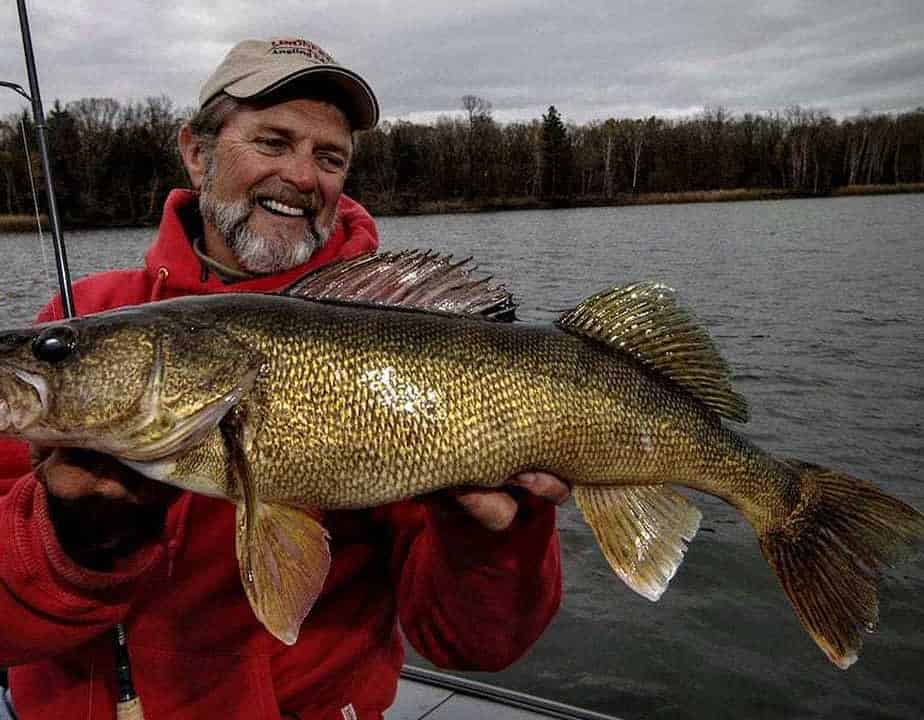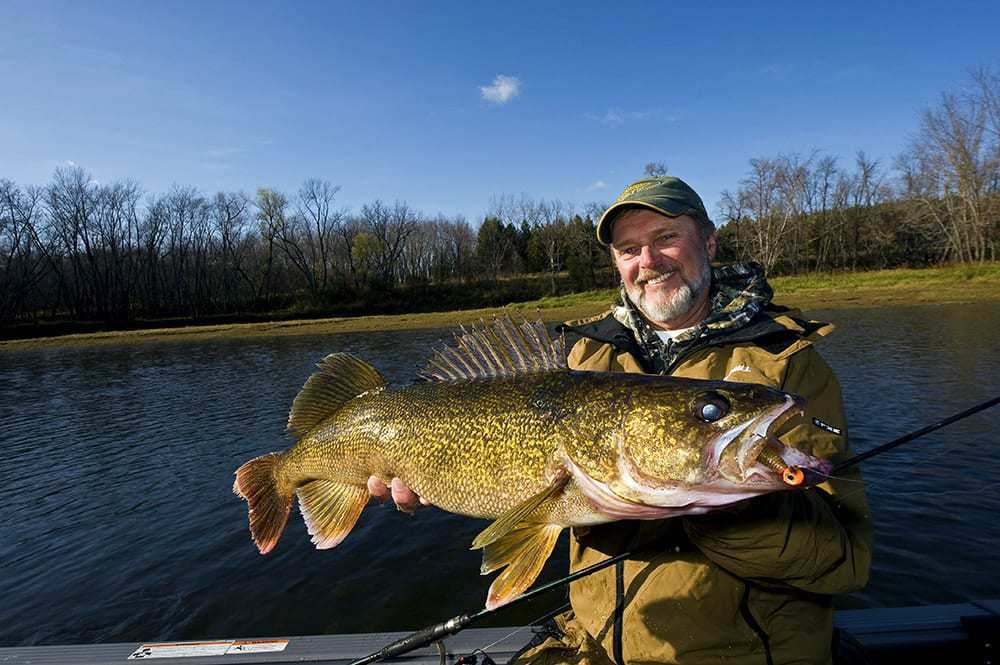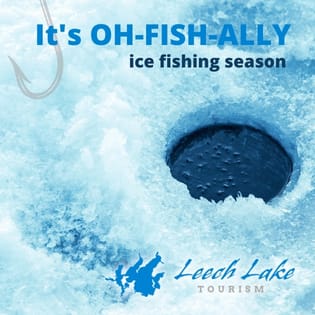Weed Walleyes: Everything You Wanted to Know
If you aren’t targeting weed walleyes, you are missing out. Historically, summer walleyes have been pigeon-holed as deep-water fish, the majority of anglers fishing the first major break line and deeper.
Walleyes can be found shallow (15 feet and under) much of the season – typically in or around vegetation on lakes, reservoirs, and rivers.
But not all vegetation is created equal. The best walleye weed areas are generally sparse with hard bottom and rock or sand composition mixed in or in the near vicinity. This is contrary to what bass anglers look for in the form of super-dense weed walls.
Why Do Walleye Use Weeds?
Number one, weed beds are often the largest food shelf in the lake, providing a buffet of insects, minnows, young-of-the-year fish, and panfish for predators like walleyes.
Second, weeds provide shade, cover, and often, more ideal water temperatures and dissolved oxygen than other areas.
Lastly, weeds provide ideal ambush spots. Nine times out of 10, a walleye will take a meal in front of its nose rather than one it has to chase down. Fish are biologically programmed to conserve energy.

Here’s a further, in-depth breakdown of each of the weed categories above:

CABBAGE
“Cabbage” is probably the top choice for summer weed walleyes in the AnglingBuzz region. But ‘cabbage’ isn’t just one kind of weed. Cabbage comprises many different varieties, including large-leaf (aka tobacco or brown), clasping-leaf (aka green or narrow-leaf), floating-leaf pondweed, whitestem pondweed, and a few others.
Of these varieties, walleyes seem to prefer clasping-leaf or large-leaf, both of which are easy to identify, once you know their characteristics (see diagram above).
The leaves of the clasping-leaf cabbage variety are typically green, wide, and wavy with a broad base that clasps the stem. Large-leaf cabbage is characterized by oval-shaped leaves. Unlike clasping-leaf cabbage, large-leaf is seldom branched.
But by the mid-summer both produce spikey, flowering tips with seed-heads that stick out of the water with leaves that stay submerged. Using side-looking technology on your fish finder is one good way to find these areas—but so is surveying areas with polarized sunglasses, especially on glass-calm days. Some anglers even go so far as to drop underwater cameras to verify vegetation type and check for the presence of forage and walleyes.
Walleye legend Gary Roach remarks, “In the old days we used to use 16’-18’ cane poles for dipping walleyes out of the cabbage. You take a shiner or leech and drop it into the openings between the cabbage clumps. Now these spots are hard to find on a lot of lakes. The cabbage used to come right up above the surface with seeds. That was always a good sign.”
Although Roach has abandoned cane poles, he says a longer spinning rod with a slip-bobber rig is a great approach. “Set the bobber stop so the bait is 5’-6’ down in these openings. Some big walleyes are in the cabbage. I also like to slow-troll slip-bobbers along weed edges in 10’-12’. I get the other guy in the boat as tight as possible to the weedline where he can work the edge by making short pitches right to the edge or pockets, and I may work a little farther out. We can cover a lot of ground.”

Like Roach, Northern Minnesota guide Tom Neustrom says the key to catching cabbage walleyes is covering water. “Pitching jigs with plastics or live bait will work, but working paddletail swimbaits like the Storm 360 GT on a steady or erratic retrieve allow you to work water quickly and find active fish.”
Neustrom continues: “It’s also hard to beat trolling spinners for shallow weed walleyes. The key there is to use an 1/8- to 3/16-ounce bullet weight, which cuts through the weeds and keeps the bait riding high above the weed tops when trolled between 1.0 and 1.25 mph. Even in deeper cabbage, walleyes will swim up to hit the bait. I use a 30” – 36” leader of 14-lb. Sufix fluorocarbon or monofilament, a #3 gold spinner on a clevis, a few beads, and a 1/O long-shank gold VMC hook. I like a longer, 7’ 6” to 8’ rod with a softer tip to let the fish pull back, which allows a smooth, sweeping hookset. I also use 10-lb. Sufix braid as my main line which is super sensitive, doesn’t sink, and cuts through the vegetation.”

COONTAIL
Another vegetation type common to the AnglingBuzz region is coontail (Ceratophyllum emersum). It’s often confused with milfoil, but the differences are apparent if you look closely. Here’s a description and identification hints from the Minnesota DNR web site, www.dnr.state.mn.us:
“Description: [Coontail] Grows underwater with no roots; upper leaves may reach the surface; central hollow stem has stiff, dark-green leaves; plants may be long and sparse, but are often bushy near the tip, giving the plant a “coontail” or “Christmas tree” appearance.
“Hints to identify: Often confused with watermilfoil, but coontail leaves are spiny and forked rather than feather-like.”
Sometimes labeled a nuisance by lakeshore owners, coontail is a vital plant to water ecosystems. It provides food, cover, and habitat for insects, minnows, fish, and many waterfowl species.
Coontail can also hold lots of summer of walleyes.
“By mid summer, coontail will look like humps on your 2D sonar,” says Brian “Bro” Brosdahl. “It may not have roots but these clumps will encompass large surfaces around bottom so they really become a piece of structure. They have edges and an underlying area. These coontail clumps are a super place to find all kinds of fish, including walleyes. They serve as a good canopy for food and predators.”
What Brosdahl likes best about coontail is it’s one type of vegetation that’s relatively hassle-free. “Coontail isn’t real sticky on lures. If your hook is exposed, yeah, you might pick up some weeds, but when it comes to running spinners or rip/pop jigging through it, you aren’t cleaning your bait all the time.”

MILFOIL
Although there are several varieties of milfoil, the two most common in the AnglingBuzz region are Northern Milfoil and the invasive Eurasian Milfoil.
Bass anglers are big fans of both vegetation types, but most anglers have no idea just how often they can catch weed walleyes.
“Milfoil is a fish magnet,” says Brosdahl. “But it’s hard to fish in. It wraps over our hooks, spinners, etc. But if you can find a milfoil edge or seam, then you’re in business for walleyes. I’ll start by using my Side Imaging to find these spots and then pitch into ‘em. But you can also troll or drag along the edges, too. Walleyes will camouflage themselves right in the thick stuff and stick their noses out to open water, whether that’s a deep break, hard bottom transition, seam, funnel, edge, whatever.”
He continues: “Milfoil walleyes are kind of a new thing to our region, but I think they’ve always been there. It’s just that our electronics are helping us open up these spots. The fish love it. Milfoil provides canopy, it’s got oxygen, it’s loaded with baitfish, crayfish… the only problem is it encompasses large areas and its hard to fish in. Edges, seams and pockets are like a guarantee. I like to find the deepest milfoil I can find. Find where it meets hard bottom and you’ve got one of my secrets. Where milfoil meets hard sand or rocks, that’s a no brainer. It’s going to load up with walleyes because it’s got the best of everything. It’s like a human shopping for a house.
When walleyes are searching through the lake they’re looking for hard bottom, food, clam shells, well-oxygenated water; then you add a milfoil edge? Yep, they’re going to put up a mailbox there. And these spots re-load with walleyes all the time. There’s always fish working that edge.
“My favorite way to fish it is to pitch jigs on safety-pin spinners or a bullet sinker and a small single hook live bait spinner rig. If you really want to make it awesome, take the live bait spinner you’re using and attach a clip-on bullet sinker or split shot right above the spinner and pitch the edge. Spot-Lock or Talon down and there will be times you’ll catch a fish on every cast. The key is putting the weight right down by the spinner and threaded on a leech or ‘crawler. Sometimes I’ll use a Slo-Death hook – or live bait keeper hook with barbs on the back. Thread a leech up on the barbs and they can’t get pulled off by the little critters.”

CHARA (AKA SAND GRASS)
Another vegetation type that attracts walleyes is chara, also known as sand grass. It’s actually a form of advanced algae the persists throughout the calendar year, unlike the mass late-summer/fall die-offs that occur with other vegetation types. As such, it attracts a lot of food and walleyes at different times throughout the entire calendar year.
“It’s my favorite walleye vegetation, period,” says Brosdahl. “It’s not just a one-season shot. Walleyes use it spring, summer, fall, and winter. It attracts crayfish, minnows, perch, darters, shiners — all the stuff walleyes love to eat. And fish lay their eggs in it. When walleyes drop their eggs, they cling to the sand grass and don’t get smothered in the bottom. It’s really some wonderful stuff. It help keeps the bottom intact and creates some structure on sand flats that otherwise would be pretty featureless. It lays in mats that creates these areas that are almost like the Great Barrier Reef on some lakes. It billows up in some areas and has lots of pockets. It will always have edges, too, and walleyes love that. You can bounce a jig through it. And if you get a little sand grass on your jig, it’s no big deal. I’ve boated up walleyes puking sand grass. They don’t seem to mind a mouthful.”
In terms of location, Brosdahl focuses on those sand grass areas in 8 to 14 feet, but in clear waters will go a bit deeper.
Besides pitching, long-lining, and casting jig and meat or plastic combos, sand grass flats are also great areas to work shad and minnow profile crankbaits, like Shad Raps, Shadow Raps, and X-Raps. Jigging Raps and Rippin’ Raps are also deadly casting or trolling the edges of these areas, especially if there’s some hard bottom to weed transitions. And at night, sand grass flats are hard to beat for long-lining the same crankbaits behind the boat, especially under a full moon.
Brosdahl adds: “Relative to sand grass is another form of filamentous algae that’s dark green to almost black and looks like dog hair. You’ll find it in a bit deeper water than sand grass – like 18 to 30 along break lines, humps and edges on our northern Minnesota lakes — but it also holds crayfish, minnows, and walleyes in the summer. It’s kind of in tufts on the bottom so you have to be careful about letting your lure touch it. It can get gobbed up pretty easy. This is where a vertical jigging or bottom bouncing game comes into play. Most fishermen hate it, but I’ve caught a lot of walleyes around this foul stuff. Fish close to it, just don’t touch it. Hold your bottom bouncer or jig where you can see it on your electronics and position just off the bottom. Adding a float by your spinner can also help so it doesn’t sag into the mess.”

What’s the best way to locate the god stuff?
So what’s the best way to find the right weeds to catch more walleyes this summer? We asked Al Lindner that very question. “Day in, day out, it comes down to using my digital lake mapping, in my case LakeMaster digital charts on Humminbird Helix units. I can usually tell by looking at the contours where the good weeds are going to be, says Lindner.
“With LakeMaster, you can set a Depth Highlight, which is the most important factor for me. Key in on the initial breakline the fish are using on the first drop-off edge, whether it’s weedline or just a natural breakline that rolls into deeper water, and you can stay spot-on all the time.”
This means Lindner can quickly glance at his screen and look for the area that he’s highlighted in green, positioning his boat to lean in and fan-cast certain points from deeper water, like holes, seams, and funnel areas in the weeds that hold walleyes.
The best weed habitat for walleyes are found on large, tapered flats, points and humps. Find erratic weed edges, pockets, and seams that form good hunting funnels for walleyes. The photo below is a good illustration of a funnel that a walleye might use.
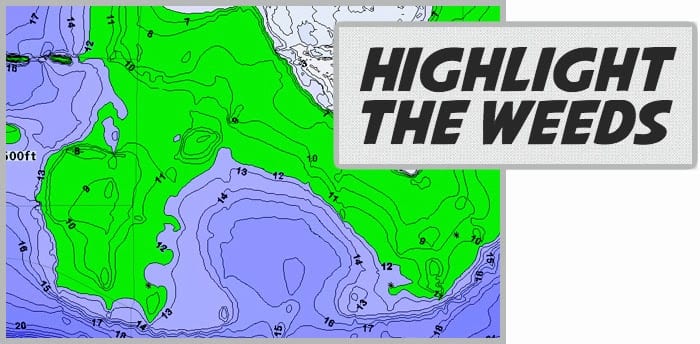
For example, if the weed edge is in 12 feet of water, Lindner will set his Depth Highlight at 9 feet and key in plus or minus three feet to reveal areas of 6 to 12 feet where the bottom flattens out, forming a funnel going up on to the flat.
“When you’re fishing shallow-water breaklines, fish will penetrate farther up into these funnel areas than you might expect. What you find is a living space that is much more extensive than the sharp breaks on the weedline. You’ll find groups of fish, not just a single here and there,” says Lindner.
He continues: “It’s astounding how many walleye fishermen avoid shallow water. They get into 12 feet or shallower and start touching weeds and they get nervous and immediately go back down. It’s mind-boggling to see guys pulling rigs, boards and vertical jigging the breakline and deeper when the walleyes are in the weeds.”
He says he used to spend hours studying paper maps to locate these kinds of spots.
“With the LakeMaster map on my Humminbird it’s the press of a button and those locations are there. Plus, now I can scan the screen for the other similar funnel habitat throughout the entire lake. It’s simple, they show up in green for go.”
Besides digital mapping, Lindner says Side Imaging has opened up weed walleyes to more anglers. Unlike traditional sonar that generates views of what’s immediately under the boat, Side Imaging allows anglers to see off both sides, revealing lake structure, cover and changes in depth and bottom composition.
“If you don’t have Side Imaging on your boat, you’re fishing blind. All the good fishermen I know are using it constantly to find any fish that swims, shallow or deep. Whenever I’m on the water I have it turned on. It’s completely changed the way we fish. It’s now simple to find everything from scattered clumps of cabbage to expansive weed beds, and all the turns, points, holes, seams, funnels, and edges to those weeds. Then it’s simply a matter of dropping waypoints and start working the areas. That’s how you find the best weeds,” says Lindner.
Lindner says Side Imaging has allowed him to tap into a virtually unexploited walleye bite that most walleye anglers miss because they’re stuck in the mindset that you have to fish deep and stay vertical.
“A sizable walleye population can be found from that first breakline and shallower on 8 to ten foot flats. Earlier in the year they’ll roam these flats eating post-spawn perch and then as the weeds start to form they’re chasing the rush of spottail shiners. Truth is, a lot of these walleyes never move deep,” says Lindner.
He says these are the same fish people catch at night while trolling cranks but can’t seem to catch during the day. Although many anglers believe these fish slide off into deeper water by day, they’re still there, just spooky, especially on clear water lakes.
“Here’s the key. Use Side Imaging to scan for little dips on the weed flats. Let’s say it’s an eight-foot flat. Chances are somewhere up on that flat it’ll roll into nine-and-one-half feet like a little depression. You get sediment and little tufts of weeds in these dips that draw in the minnows to feed, and in turn, weed walleyes,” says Lindner.
Side Imaging reveals these depth gradients in variations of light and dark, depending on the color palette you choose. So, by scanning for these shading variations you’ll begin to notice what appears like little ditches.
He also recommends scanning shallow flats for isolated areas of scattered rock.
“Rocks show up clear as day on Side Imaging. On shallow water flats it could be a small band that’s no more than 15- or 20-feet wide. These are the kinds of spots on the spots that consistently hold fish and are overlooked because everybody’s sitting on the first breakline and on down, not up,” says Lindner.
Once located, your Side Imaging scale will tell you exactly the distance off the right or left side of the boat where the structure’s located. Then it’s simply a matter of lining up your casts from as far away as possible to avoid spooking the fish.
“Jigs and plastics are my go-to confidence bait. I don’t know of anything that works better. Guys will back-troll over those fish with rigs and cranks and spook ‘em. You’ll catch far more fish by making long casts to them, even in high winds. It’s just that simple,” says Lindner.
Here’s an exact breakdown of Al Lindner’s “rip jigging” setup, which is his primary go-to for weed walleyes (video):
If you’re looking for more information on catching walleyes during the summer, make sure you check out one of the most popular articles on our website: “Ask the Pros: What’s Your Go-To Technique for Summer Walleyes”
The cool thing about the article above is that almost all of the anglers chose different tactics, and many of them mentioned fishing in the weeds while everyone else is out on the deeper break lines.
What Should You Bring?
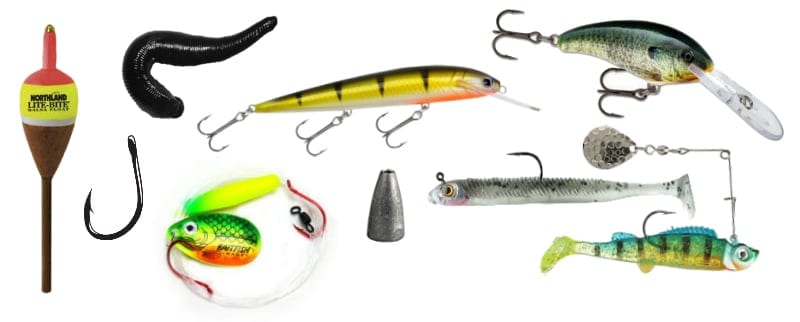
Our favorite weed walleyes presentations:
– Bullet sinker spinner rigs
– Slip bobber rig
– Assorted crankbaits (minnow & shad profile)
– Safety-pin spinner
– Jig with a plastic swimbait
The ideal presentation can vary depending on the mood of the fish and the condition/type of weeds you’re fishing.
Bullet sinker spinner rigs are the primary weapon of choice for many of the top walleye anglers in the north country. They allow you to cover water extremely quickly, and they get bit. Use heavier and lighter bullet sinkers based on where you want the rig to be running in the water column in relation to the weeds.
On the other end of the scale, slip bobbers are the slowest technique on this list, but it’s also one of the most effective, especially if the walleyes are in a negative or neutral mood. Tipped with a leech or another livebait option, slip bobbers can be absolutely deadly for weed walleyes.
Crankbaits can be an effective tool for catching weed walleyes, as well. They can be fished quite quickly and can load the boat with ‘eyes when the conditions are right. The big downside to cranks is that they get hung up quite easily with their treble hooks dangling below. In order to efficiently deploy cranks, make sure you’re running them outside the edge or overtop of the weeds.
Of all the presentations on this list, safety-pin spinners are often the most overlooked. They can be fished quite quickly, and while they might not trigger as many bites, they produce some plus-sized kickers. When you catch’em, they’re usually pretty nice.
Let’s rap things up with Al Lindner’s personal favorite: a jig and plastic. This is the ultimate reaction bite for walleyes, and it’s a mainstay technique for most of the top walleye anglers in the north country. Fish it in sparse, broken up weed cover with an aggressive ripping motion. It’s quite efficient and catches some real hawgs to boot!
